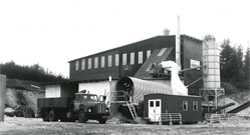Customised silica sand

Sand is not just sand. Different customers and industries place different demands on the properties of the sand.
Good sand must be clean and must have a high content of silica. But it is just as important that the sand has a precise and well-defined grain curve. The ratio between small, medium and large sand grains is crucial for the properties of the material and the purposes for which it can be used.
For example, a steep grain curve, where there is a small gap between the smallest and the largest sand grains, ensures that the sand has a good hydraulic conductivity. Conversely, a slightly wider grain curve with several different grain sizes will ensure that the sand is easily compacted.
That is why our sand is “tailor-made”.
This is done in a carefully controlled production process. Once we have dug the raw sand from the subsoil, we wash it clean of stones, clay and coal. At our water sorting plant, we separate and classify the sand, and dry it using natural gas so that it is free of bacteria and organic matter. We then sift it into various grain sizes.
Finally, we mix the sifted sand into individual sorting, enabling our customers to produce mortar for house construction, cast wood stoves, filter drinking water, create world-class golf courses and sports stadiums or enjoy beautiful, weed-free joints on the patio and driveway.






The Scandinavian rock formations in the Miocene period consisted of minerals such as potassium feldspar, plagioclas, muscovite, biotite and quartz (silica). Mountains are eroded by mechanical wear and tear by water (rain) and through chemical decomposition – and the more silica (SiO2) the mineral contains, the longer it takes to decompose. Quartz consists of pure SiO2 crystals, and will remain intact for much longer than most other compounds.
As the mountains eroded over millions of years, the rocks were ground down to sharp-edged grains that were washed out and deposited in the river delta. In a wide, slowly flowing river, it can take thousands of years for a grain of sand to reach all the way to the sea, and along the way most of the minerals dissolve – basically only pure silica is left.
At the same time, the individual quartz grains are ground and given the shape called “rounded edge”, which is characteristic of Dansand’s silica sand. Rounded-edge silica sand is extremely mechanically strong and can therefore withstand very high compression forces. The angular grain shape gives the sand extremely good properties in terms of strength.






